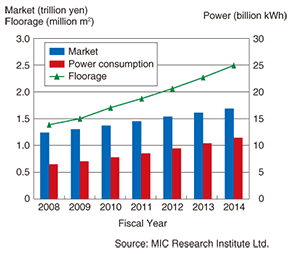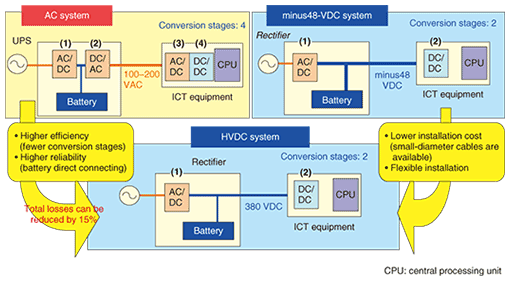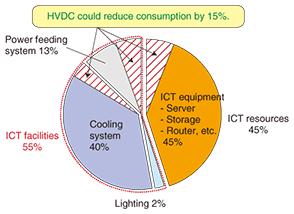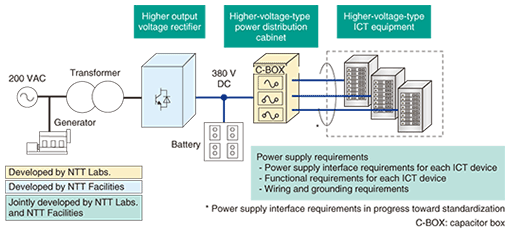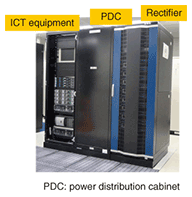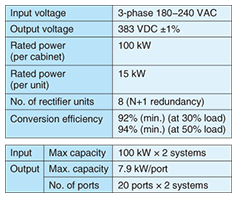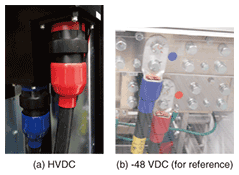 |
|||||||||||||||||||
|
|
|||||||||||||||||||
|
Feature Articles: Environment and Energy Technologies Toward a Green Society Vol. 9, No. 2, pp. 13–18, Feb. 2011. https://doi.org/10.53829/ntr201102fa2 Higher-voltage Direct Current Power-feeding SystemAbstractIn this article, we introduce activities aimed at spreading the use of higher-voltage direct current (HVDC) power-feeding systems. We introduce the state of development of HVDC systems, improvements in operability, and standardization trends.
1. IntroductionWith the recent spread of optical fiber services, the resulting improvement in environments for Internet use has made the use of high-volume content such as video commonplace, and the overall volume of Internet traffic has increased sharply. According to a report by the Ministry of Economy, Trade, and Industry (METI), the power consumed by information and communications technology (ICT) equipment such as servers and routers continues to increase every year. It is expected to exceed five times the 2006 levels by 2025 and to account for more than 20% of domestically generated electrical power [1]. Trends and forecasts for the Japan datacenter market and its power consumption are shown in Fig. 1. All items show a year-to-year increase, and yearly power consumption is expected to exceed 10 billion kWh in FY2013. Power consumption at datacenters running large amounts of ICT equipment, such as servers and routers, is already a major issue.
Examples of energy saving initiatives at datacenters are shown in Fig. 2. Power consumption is being reduced by replacing ICT equipment in the datacenter by low-power equipment. Utilization rates are being improved through technologies such as virtualization and cloud computing, which also contribute to power saving in datacenters, and improvements are also being made to datacenter facilities, such as the air conditioning and power supplies for ICT equipment.
Higher-voltage direct current (HVDC) power-supply technology improves the supply of power to ICT equipment and also contributes to energy savings in the overall system, including aspects such as air conditioning. For these reasons, organizations around the world have begun studying the use of DC power for datacenters, where AC power supply has been the norm. 2. HVDC power supply systemsThe advantages of DC power supply systems are shown in Fig. 3. Compared with AC power, DC power uses fewer conversion stages from AC to DC and from DC to AC, which reduces conversion losses, and the reliability of DC systems is 5 × 10-7, which is more than an order of magnitude better than that of AC power systems.
A –48-VDC power supply system is already in wide use for telecommunications systems, making maximum use of its energy savings and high reliability. Increasing the voltage to 380 V reduces the amount of current required to supply power, so power cables can be made thinner, which reduces facilities costs for cabling. An example of the breakdown of power consumption in a datacenter using an AC power supply system, together with the expected reductions due to switching to HVDC system are shown in Fig. 4. Compared with the AC power supply system in Fig. 3, the DC/AC conversion at (2), and the AC/DC conversion at (3) will be unnecessary with DC power, so conversion losses will be lower. Furthermore, the heat generated by ICT equipment and power supply systems and the accompanying power consumption will also be reduced, so effective overall consumption is expected to be reduced by 15% or more [2].
3. HVDC developmentThe architecture and external views of the HVDC power supply system being developed by the NTT Group are shown in Figs. 5 and 6, respectively. The architecture is similar to the conventional –48-VDC system. The HVDC system is composed of a rectifier, batteries, a power distribution cabinet, and ICT equipment designed to run on higher voltages (see Table 1). The system is rated for 100 kW output at 380 VDC. It takes commercial AC power and rectifies and converts it to 380 VDC, and this is used to float-charge batteries and supply power to the DC power distribution equipment, which distributes it to the ICT equipment. The power distribution equipment also has internal capacitors that stabilize the power supply system, suppressing faults such as oscillations, as well as fuses that immediately disconnect ICT devices in the unlikely case of a fault occurring. This minimizes any effect on other ICT equipment. The equipment also provides continuous, uninterrupted power through batteries or emergency generator equipment, which act as backup power sources during power outages. All power supply requirements for providing stable and safe power were studied and regulated, including power supply interface requirements, functional requirements, and wiring and earthing requirements.
4. Improvements for safety and deploymentSince an HVDC power supply system uses higher voltages than conventional –48-VDC power supplies, human safety must be considered carefully. Equipment must be developed with attention paid to additional safety issues, especially for direct current, such as arcing that can occur when a connection is cut while current is flowing through it. The architecture of our system includes a grounding mechanism to avoid cases of shock at all costs and to minimize any effect on the human body. Moreover, connectors are constructed as shown in Fig. 7, concealing any electrically live parts to prevent any contact.
NTT Facilities has also developed an HVDC power bar and power plugs which enable ICT equipment to be connected and disconnected safely. These are structured so that electrically live elements cannot be touched, and when the plug is removed, a mechanical switch with an internal safety mechanism that forcibly breaks any arc is moved to the off position. These improvements not only enable safe operation, but also make connecting and disconnecting power easier. 5. Migration to new equipmentWhen an HVDC power supply system is introduced, ICT equipment supporting HVDC power, such as servers and communications equipment, must also be procured in addition to power equipment such as rectifiers and distribution equipment. It is likely that initially, not all of the required server and communications equipment will support higher-voltage power, so rather than changing the entire power system framework, we have developed migration equipment which converts 380 VDC to 100 VAC, 200 VAC, and –48 VDC. This allows partial use of equipment that requires these conventional formats. This migration equipment enables the HVDC power supply system to be introduced smoothly, including during the transitional period as products supporting HVDC spread. 6. System testingSince FY2008, the NTT Group has conducted repeated practical tests of safety and other factors at three demonstration sites within Tokyo, including basic power supply operation, long-term operating characteristics, and safety tests for potential incidents such as short circuits. Commercial devices have been developed with improvements to overcome issues found in early prototypes, such as circuit-breaking characteristics and increased density, and we have confirmed that these products can supply stable power safely for the range of ICT operating voltages [3]–[5]. Moreover, a demonstration test conducted last year by NTT DATA received the Green IT Award 2009 from METI [6]. For this demonstration, the HVDC power supply system exhibited stable operation and achieved a significant energy saving effect of 17% compared with AC power [5]. 7. Standardization trendsHVDC power supply systems are attracting worldwide attention as a way to decrease ICT power consumption as it continues to increase each year. In order for such systems to spread widely, it is desirable for the interfaces between power supply equipment and ICT devices be standard and of uniform specification globally and for devices to be built, purchased, and used according to these specifications. Standardization activities are in progress at the International Telecommunication Union, Telecommunication Standardization Sector (ITU-T) and the European Telecommunications Standards Institute (ETSI) on HVDC power-supply interface requirements specifications for ICT equipment in telecommunications facilities and datacenters. Requirements such as the range of power-supply voltages, requirements for grounding and safety, and environmental impact are all being studied [7]. Awareness of DC power supply and distribution has also increased dramatically recently, with the growing use of solar panels and fuel cells, electric automobiles using DC power, and next-generation smart grid technology. Considering these factors, the International Electrotechnical Commission (IEC) established a new strategic group in 2009, Strategic Group 4 (SG4), to begin studying low-voltage* DC power distribution. HVDC power supply systems are also being examined as one aspect of DC power distribution and specific standardization work is planned in Technical Committees regarding electrical facilities; distribution protection equipment such as switches, breakers, fuses, etc.; ICT and audio-visual equipment such as digital electronic equipment; outlets; and electromagnetic compatibility, insulation, and safety, etc.
8. Future developmentsThe advantages, development status, and standardization activities of an HVDC system were described. The NTT Group has evaluated it in practical tests and confirmed the power supply operation characteristics. We intend to introduce the system into actual use and establish an environmentally friendly datacenter. References
|
|||||||||||||||||||








